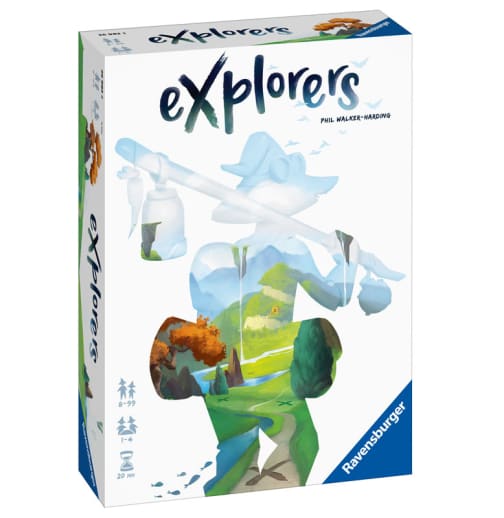This is the perfect beginning “flip and write" game journey! Each player starts with his or her own game board and a dry-erase marker. Choosing from eight different map tiles with arrangements consisting of four different terrains, all players set four of the same tiles with the same orientation into their game board. Each player picks the starting point, which is a village closest to the center of their map, and gets ready to explore their new world! From a stack of Terrain Tiles, the starting player draws a tile that consists of two types of terrain and chooses one type to cross off three matching terrain spaces on their map board that are contiguous beginning from their “start point" that was chosen during game setup. Their fellow players then decide whether to use the same terrain and cross off two of their spaces or the “unchosen" terrain depicted on the tile to mark off three map squares. Keeping their exploration to spaces that are adjacent to crossed off areas, players encounter objects such as keys that unlock temples, scrolls that will let them choose any terrain to explore, horses that allow them to place one X on any terrain of their choice as well as provisions (apples, carrots and fish), gemstones or villages that will give them points to add up each round. Play continues with rotating start until all the tiles have been used which ends the round. Each player totals up bonuses earned during the round, the terrain tiles are shuffled, and the next round starts. Once four rounds are completed, players total points from all four rounds and the player with the most points is the winner of the game. This game includes a solo mode that lets a player challenge their best score! For 1-4 explorers with a 20-minute playtime.
Ravensburger Explorers Game
SKU
012410
Grade 3-AD
These icons are designed to help you quickly understand and learn important information about our products.
Teaching Method
Traditional
Teacher-centered curriculum commonly used in classrooms that may include a text, teacher manual, tests, etc.
Charlotte Mason
A methodology based on the work of a 19th century educator who maintained that children learn best from literature (Living Books), not textbooks.
Classical
A methodology based on the Latin Trivium (three stages of learning), including the grammar stage (memorization and facts), logic stage (critical thinking), and rhetoric stage (developing/defending ideas).
Unit Study
A thematic or topical approach centered around one topic that integrates multiple subject areas.
Montessori (Discovery)
A methodology based on the work of a 20th century educator that emphasizes student and sensory-driven discovery learning and real-life applications.
Other
Other methodologies
Religious Content
Secular
Contains content contrary to common Christian beliefs (i.e. evolution).
Neutral
Avoids religious or theoretical topics or presents multiple viewpoints without preference.
Christian/Religious
Faith-based or including instructional religious content.
Learning Modality
Auditory
Learns through listening, talking out loud or reading out loud.
Visual
Learns through seeing, prefers written instructions and visual materials.
Kinesthetic/Tactile (Hands-On)
Learns through moving, doing and touching.
Multi-Sensory
Curriculum that employ a variety of activities/components.
Presentation
Sequential
Curriculum progresses through well-defined learning objectives. Emphasizes mastery before moving to the next topic.
Spiral
Topics and concepts are repeated from level to level, adding more depth at each pass and connecting with review.
Conceptual/Topical
Focus is on the “why,” often with a unifying concept as well as specific skills; coverage may be broader.
Teacher Involvement
Low Teacher Involvement
Student-led materials; parent acts as a facilitator.
Medium Teacher Involvement
A mix of teacher-led time and independent student work.
High Teacher Involvement
Teacher-led lessons; may utilize discussions, hands-on activities and working together.
Additional Materials Required
No other materials needed
Everything you need is included.
Other Materials Required
There are additional required resources that are a separate purchase.
Other Materials Optional
There are additional resources mentioned or recommended but are not absolutely necessary.
Consumable
Consumable
Designed to be written in; not reusable.
Non-Consumable
Not designed to be written in; reusable.
Our Price
$26.99 $26.99 $19.97
Rainbow Savings: $7.02
Description
Publisher's Description of Ravensburger Explorers Game
In this flip and write game, you'll travel through a beautiful landscape made up of prairie, water, desert, and mountains. Using the included dry-erase marker, mark your travel with X's on your map as you go, while coming across different places and objects made up of provisions, precious stones, villages, animals, and even keys that open hidden temples. All help players earn points. Because all players explore the same landscape during the game, it's your decisions that determine who wins and who loses.
Details
| Product Format: | Other |
|---|---|
| Grades: | 3-AD |
| Brand: | Ravensburger |
| EAN/UPC: | 4005556269822 |
| Length in Inches: | 9 |
| Width in Inches: | 6.5 |
| Height in Inches: | 2.125 |
| Weight in Pounds: | 2.15 |
Videos
Reviews

